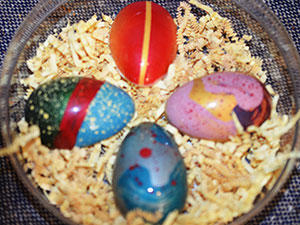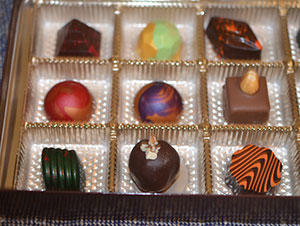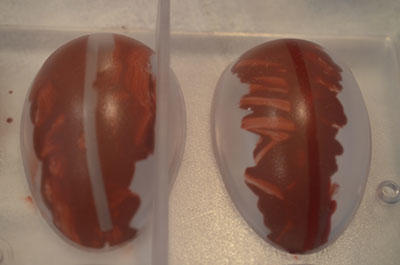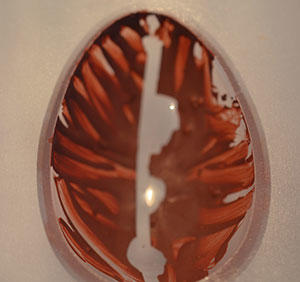-
Posts
2,417 -
Joined
-
Last visited
Content Type
Profiles
Forums
Store
Help Articles
Everything posted by Jim D.
-
My Easter chocolates for 2018. First, the eggs: Clockwise, beginning with the red egg at top: strawberry pâte de fruit & strawberry buttercream, coffee ganache and rum buttercream, crispy hazelnut gianduja, dark caramel with Maldon sea salt. Then the boxed selection: Top row: (1) dark caramel with Maldon sea salt in dark chocolate, (2) coconut ganache & lime cream in white chocolate, (3) orange caramel with balsamic vinegar in dark chocolate. Middle row: (1) dark chocolate ganache with raspberry purée & rosewater in milk chocolate, (2) ganache flavored with Earl Grey tea in milk chocolate, (3) black currant ganache & crispy hazelnut gianduja dipped in milk chocolate and topped with a toasted hazelnut. Bottom row: (1) Morello cherry pâte de fruit & pistachio gianduja in dark chocolate, (2) chocolate chip cookie truffle dipped in dark chocolate, (3) mango pâte de fruit & mango ganache in dark chocolate.
-
I would strongly echo what @pastrygirl says about looking at packaging early in the process (written from some bitter experience ) because there are some decisions you make that can't be undone without considerable expense. If, for example, you want to use plastic trays (inserts) to hold the bonbons inside a box (which I highly recommend--as opposed to individual cups--for ease of assembly), there are only certain sizes that are manufactured in bulk. Whatever size tray you choose in turn determines what size chocolates you need to make (or can make), and that, of course, determines what molds you can use. For example, after buying far too many molds that make small chocolates, I got into making many bonbons with layers, and those are very difficult to make in small chocolates. So I moved to larger individual pieces. You can see that that decision affects the trays you will need. If you have custom trays made (which I have done once), it is very, very expensive--who knew that those clear plastic boxes that hold produce cost so much? So I would recommend looking at the packaging companies in some detail to see what is out there. There are lots of recommendations on eGullet, and I can provide some when you get to that point (I spent much of a summer researching this). It's far easier to get a "system" that includes boxes and trays that match, but then you need to look out for box height not being tall enough to hold your bonbons--just adding a toasted hazelnut to the top of a piece eliminates a lot of boxes out there! I ended up having custom boxes made because of the issues of height (not tall enough) and cavity size (not large enough) in stock boxes. I think packaging is crucial to the "look" of your product. That takes us back to the guitar size topic. It's linked to a lot of other issues, as has been said in this thread. As for using the guitar, there is a long thread on this. I recommend you read it if you haven't already. It even includes a link to a helpful video from pastrygirl on replacing guitar wires--a dreaded topic for all users of guitars. Having the right texture in what is being cut is crucial, and once you replace a guitar wire, you will know why!
-
If you want 1" squares, you need the 5mm. That base can utilize any frame with spacing of wires in a multiple of 5mm. Of course, to be exact, the 5mm squares aren't exactly 1"; they are 0.984252" 20mm and 35mm frames also fit that base and make a very nice size of bars.
-

Spraying Chocolate: Equipment, Materials, and Techniques
Jim D. replied to a topic in Pastry & Baking
I must confess I had to look up what a "cl" is and discovered it that is less than 1/3 of a fluid ounce. That's practically nothing. I am quite surprised that so little cocoa butter works. But I imagine that cleaning out the container is quite a job--compared to the little cup on an airbrush. Is there some setting on the HVLP itself for lowering the pressure and/or doing splatter, or was this just experimentation on your part? I don't think manufacturers of HVLPs probably foresaw this use of their product! -

Spraying Chocolate: Equipment, Materials, and Techniques
Jim D. replied to a topic in Pastry & Baking
Thanks for that intriguing idea. So he dipped the head of the airbrush into the CCB? Did you see if he lowered the pressure? I'm glad you mentioned Savour because it reminds me that I am going to sign up for the videos when I have some free time in the near future. Do you think this video is part of the Savour online courses? -

Spraying Chocolate: Equipment, Materials, and Techniques
Jim D. replied to a topic in Pastry & Baking
@Rajala, and @julie99nl: Do you have a link to a photo of the type of HVLP gun you have? I began a look on the Wagner site but was overwhelmed by the selection. They mostly appear to be the siphon type. -

Spraying Chocolate: Equipment, Materials, and Techniques
Jim D. replied to a topic in Pastry & Baking
Good point. So the HVLP does not have a needle? I'll see if I can find one that has a paint container with a small capacity--perhaps a wild goose chase? -

Spraying Chocolate: Equipment, Materials, and Techniques
Jim D. replied to a topic in Pastry & Baking
I already have a 0.7mm nozzle on the Grex (the largest they make). -

Spraying Chocolate: Equipment, Materials, and Techniques
Jim D. replied to a topic in Pastry & Baking
Thanks for that information. I don't see any reason why my Grex airbrush (or any airbrush, for that matter) can't do the same. I have a pressure regulator installed between the hose from the compressor and the airbrush itself, so changing the pressure is easy. I will have to try again. I tried the spraying with a wooden stick or spatula between the brush and the mold to create splatter, but it is erratic (I have seen it done successfully in person, so I know it's just a matter of technique). I think the drop-cocoa-butter-from-the-bottle-and-spray-it-into-the-mold technique would be something that would take (for me) a lot of practice. Sad to confess, but the best I have done so far has been with a toothbrush. -

Spraying Chocolate: Equipment, Materials, and Techniques
Jim D. replied to a topic in Pastry & Baking
I just read through this entire thread. You said you got an HVLP paint gun and also mentioned at one point that you had ordered an airbrush, but never said what brand it was. I bring this up because I am wondering whether you used the HVLP gun or the airbrush for the splatter. I have seen the Fuji in action, and it does splatter quite well. But most (if not all) paint guns have a rather large container for the paint. The ones I have seen would take a great deal of cocoa butter just to have enough to cover the bottom of the container. That is what kept me from buying one. So if you used the paint gun for the splatter, could you describe what amount of c.b. you used for the job? If you used an airbrush, I would love to know how you made it splatter. I am finding with my new Grex gravity-feed airbrush, I am using much more c.b. than I did with the siphon-style Paasche airbrush I used formerly. I can't quite imagine using a paint gun for just a few molds, considering how much c.b. it requires and how difficult it must be to clean out the container. -

Spraying Chocolate: Equipment, Materials, and Techniques
Jim D. replied to a topic in Pastry & Baking
How did you get the nice even splatter on those molds? -
Thanks, @paulraphael, for the link to the very helpful article. @Pastrypastmidnight, I don't know where you live, so can't say much about where to buy chocolate. My impression, though I don't know for sure, is that the manufacturers don't sell directly to customers. In the U.S., Chocosphere has an extraordinary selection; they sell both retail as well as wholesale to businesses (that's where I got the prices I mentioned). They also repackage many chocolates so as to sell them in smaller quantities. If you are a business, you have many other options for wholesale purchases, but these are often regional companies that sometimes require large purchases.
-
If El Rey Icoa is the chocolate I think it is, then I tasted it and hated it, so you will have to take the rest of what I write in that light. I tend not to like whites that try for a chocolatey taste because I think they taste like washed-out milk chocolate. Obviously a "favorite" white chocolate is a matter of very personal taste. My favorite white, without any question, is Valrhona Opalys; second choice is probably Cacao Barry Zephyr. Both are less sweet than many other whites. Besides the usual dairy and vanilla flavors one expects, it seems to me (again, very personal taste) that Opalys has a hint of something citrus. I know this is unlikely to be true, but whatever it is, I think it gives Opalys a taste beyond just cocoa butter + dairy (the norm). I use Opalys for molding and for making ganaches. As for how it handles, well, that is a different story. It is very challenging to use for molding. After it is in temper, it starts off rather thin. You have to look carefully at any shells to make sure they are not too thin (and sometimes fill them again). After about the fourth or fifth mold, however, Opalys thickens rather suddenly. The clue is that after scraping the top of the mold, the edges of some cavities fall inward, forming a too-thick shell. To make sure I wasn't just incompetent, I took some Opalys to the 2017 chocolate workshop, and Kerry Beal tempered it. It behaved exactly the same way, and was so thick at the end that it was almost solidified (I suspect those standing around must have thought I was insane to use such a chocolate). Previously Kerry had asked the people at Valrhona about my difficulties with Opalys, and, to my relief, they confirmed that it could be a problematic product. But the good news is that Opalys can be tamed: If I am doing more than 4-5 molds, I have a second amount set aside, initially raised to a high enough temperature that it cannot be in temper and then held around 90F. When the over-crystallizing begins, I stop and pour in some of the extra Opalys; if I have been successful, the chocolate returns to a usable state. Why go through all this? Because I think it tastes that good (for a white chocolate, of course). If you think Icoa is expensive, however, then I'm afraid you will find Opalys astronomical (about $72 for 3-kilo bag wholesale, about $96 retail). As for Cacao Barry's Zephyr, it costs about $83 for 5 kilos (dramatically lower, I would say), and I think it tastes almost as good as Opalys. I have tasted some other whites, including new ones Valrhona has released, but did not care for any of them. I thought the Callebaut W2 was much too sweet. Probably more information than you wanted, but finding a good white has been a goal of mine.
-
I just made some of Kerry's strawberry butter cream. I sometimes make raspberry. In both of those I substitute some plain cocoa butter for part of the white chocolate, allowing more fruit flavor to come through. When making a non-fruit one, I have found that it takes too much whiskey to give any flavor, so use dark rum. I also make a creme brûlée filling, adding a layer of crushed caramel below the vanilla-flavored butter cream--for reasons that mostly escape me, people love it. So I use Kerry's basic recipe rather often. The problem is getting enough flavor without making the filling too thin to set up.
-
No, I haven't used fruit powder. Might make a difference. By the way, I find that even vanilla fades somewhat--even though I use a lot of it to mask the unpleasant flavor of the gelatin. Another possibility is to add concentrated flavoring. Amoretti has some natural ones. I have tasted the pineapple and mango, and they are delicious and powerful. As for blueberry, after making my own purée and concentrating it to make a ganache for chocolates, I eventually gave up because the flavor was too muted to be recognizable.
-
Beautiful job of making and dipping the marshmallows. I have had the same experience with the flavored marshmallows. The strawberry ones (nightscotsman's recipe) retained a little strawberry flavor, but only a little. Passion fruit ones (I think of passion fruit as a very assertive flavor that overpowers almost anything else) lost all taste of the fruit after a few days.
-
Chocosphere has Abinao in 1 and 3 Kg bags. In looking for it, I see that they now have the new Valrhona "Inspirations" that you pointed out a while back.
-
Another try proved more successful (one on the left, stripe left clear; on the right; red cocoa butter, which unfortunately does not show up well in a photo): The photo shows more imperfections than there actually are, so I think these would be usable. The difference between these tries and the preceding one was that I did not let the c.b. dry completely, just until it was set and no longer runny. The problem is with doing these in any substantial numbers. I would have to airbrush one mold (tape in place), wait just the right amount of time for the c.b. to begin to crystallize, remove the tape, then do the same with the next mold. If others have had success with letting the c.b. dry completely before removing the tape, I would love to hear about it and know what you did differently.
-
I should name this post "Defeated by Stripes" because that's how I feel. I bought the tape that @tikidoc used. I thought the fact that it appears to be plastic and not paper would make a difference (and it did for her). But I used a brush to apply color to a mold (ignore the feathery part at the edges--I didn't care about covering the entire mold). I applied the cocoa butter somewhat more thickly (but not a lot) than I usually do because I wanted to simulate airbrushing--where the thickness is difficult to control. I let the cocoa butter dry (as would happen in an airbrushing situation, where going from one mold to another gives the c.b. time to crystallize). You can see that the stripe is not what one might call a success: As is obvious, when I removed the tape, the flaking was very bad.
-

Spraying Chocolate: Equipment, Materials, and Techniques
Jim D. replied to a topic in Pastry & Baking
I very much liked the Harvest Purple in theory (the idea of a Victorian "dusty" purple color appealed to me), but I gave up on it because, once applied, it looked too much like milk chocolate. And what's the point of that? So the only purple I use is Purple Rhodolite (from the "Jewel" collection). It shows as purple (well, somewhat) even when applied to dark chocolate, and I use it for my plum and my fig fillings, as well as on Easter eggs--where I mostly abandon the idea of matching the color to what's inside. -

Spraying Chocolate: Equipment, Materials, and Techniques
Jim D. replied to a topic in Pastry & Baking
Yes, I have a dark and a light purple. I will give the dark one a try. Thanks for the idea. -

Spraying Chocolate: Equipment, Materials, and Techniques
Jim D. replied to a topic in Pastry & Baking
Before I waste a lot of colored cocoa butter experimenting, does anyone know what I can mix to get a dark/navy blue? I have on hand (all Chef Rubber named colors) turquoise, teal, Mediterranean blue, and black onyx. It's too late for me to order one of their darker blue colors. -
I believe she said previously that she has the spray booth in her basement.
-
Excuse my ignorance (and all the questions), but is the piece with the white frame the home air filter you mentioned? What is the crisscrossed item outside the booth? And is the fan directly next to the outside of the booth? How quickly does the filter get completely covered with cocoa butter and need to be replaced?
-

Spraying Chocolate: Equipment, Materials, and Techniques
Jim D. replied to a topic in Pastry & Baking
I should add that the molds you used could not have been easy to tape. I will be using a demisphere, which is much more open and allows for more "finger space" to do the taping. I once used the blue painter's tape just as an experiment, and it allowed a lot of bleeding, but I was using a regular dome. By the way, do you allow the chocolate to dry totally before removing the tape or do it sooner?






